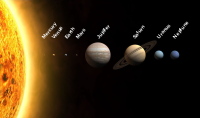
Photo from wikipedia
Significance We present a coordinated petrologic, mineral chemistry, and multi-isotopic investigation of individual chondrules to further elucidate the origins and formation histories of planetary materials. We show chondrules from certain… Click to show full abstract
Significance We present a coordinated petrologic, mineral chemistry, and multi-isotopic investigation of individual chondrules to further elucidate the origins and formation histories of planetary materials. We show chondrules from certain meteorites that accreted in the outer Solar System contain an assortment of both inner and outer Solar System material, as well as previously unidentified material. The outward transport of inner Solar System material places important constraints on dynamical models, as outward transport in the disk was thought possible only if significant barriers (e.g., Jupiter) to radial transport of materials do not exist. We show this “barrier” is either not completely impermeable to transport of millimeter-sized materials or additional mechanisms are required to transport materials to the outer Solar System. Dynamic models of the protoplanetary disk indicate there should be large-scale material transport in and out of the inner Solar System, but direct evidence for such transport is scarce. Here we show that the ε50Ti-ε54Cr-Δ17O systematics of large individual chondrules, which typically formed 2 to 3 My after the formation of the first solids in the Solar System, indicate certain meteorites (CV and CK chondrites) that formed in the outer Solar System accreted an assortment of both inner and outer Solar System materials, as well as material previously unidentified through the analysis of bulk meteorites. Mixing with primordial refractory components reveals a “missing reservoir” that bridges the gap between inner and outer Solar System materials. We also observe chondrules with positive ε50Ti and ε54Cr plot with a constant offset below the primitive chondrule mineral line (PCM), indicating that they are on the slope ∼1.0 in the oxygen three-isotope diagram. In contrast, chondrules with negative ε50Ti and ε54Cr increasingly deviate above from PCM line with increasing δ18O, suggesting that they are on a mixing trend with an ordinary chondrite-like isotope reservoir. Furthermore, the Δ17O-Mg# systematics of these chondrules indicate they formed in environments characterized by distinct abundances of dust and H2O ice. We posit that large-scale outward transport of nominally inner Solar System materials most likely occurred along the midplane associated with a viscously evolving disk and that CV and CK chondrules formed in local regions of enhanced gas pressure and dust density created by the formation of Jupiter.
Journal Title: Proceedings of the National Academy of Sciences of the United States of America
Year Published: 2020
Link to full text (if available)
Share on Social Media: Sign Up to like & get
recommendations!